光与二能级原子的相互作用
- 格式:docx
- 大小:96.36 KB
- 文档页数:3
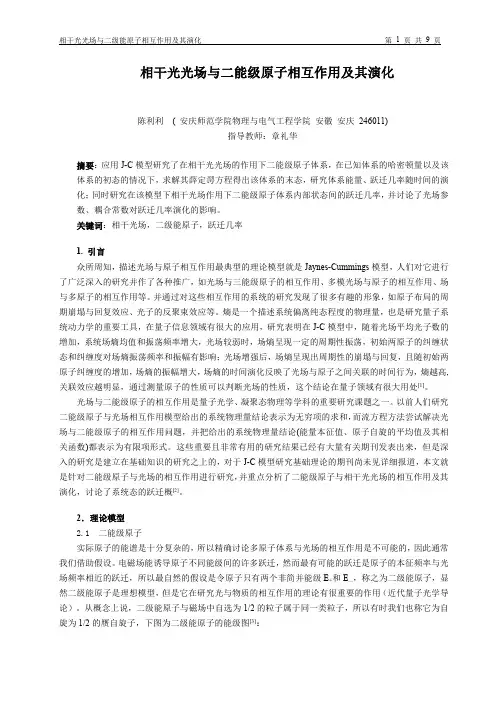
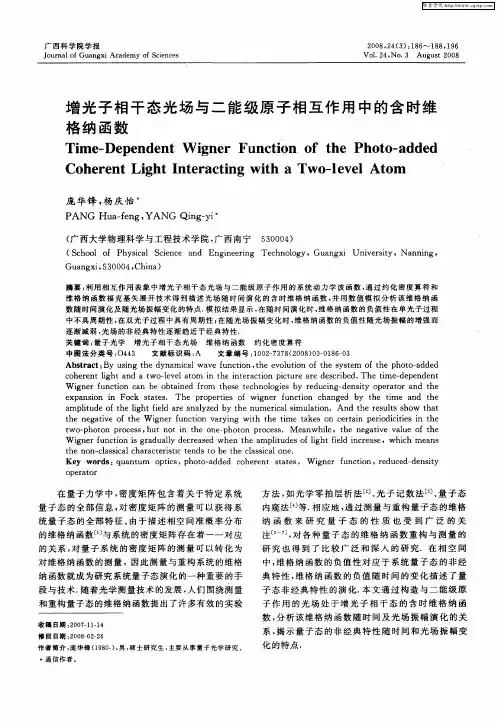
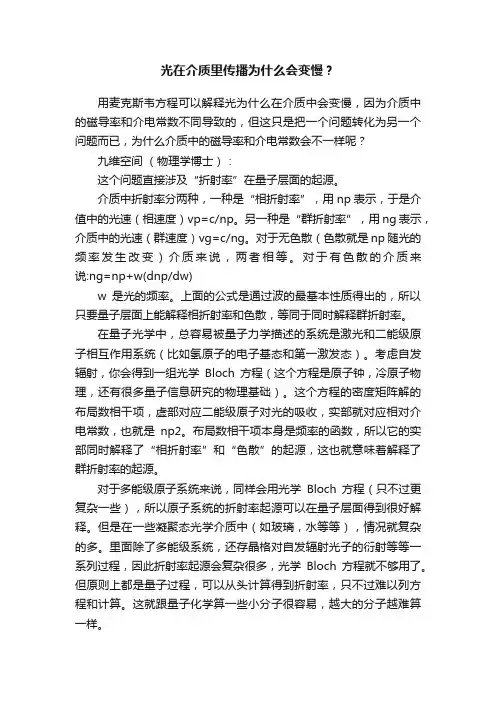
光在介质里传播为什么会变慢?用麦克斯韦方程可以解释光为什么在介质中会变慢,因为介质中的磁导率和介电常数不同导致的,但这只是把一个问题转化为另一个问题而已,为什么介质中的磁导率和介电常数会不一样呢?九维空间(物理学博士):这个问题直接涉及“折射率”在量子层面的起源。
介质中折射率分两种,一种是“相折射率”,用np表示,于是介值中的光速(相速度)vp=c/np。
另一种是“群折射率”,用ng表示,介质中的光速(群速度)vg=c/ng。
对于无色散(色散就是np随光的频率发生改变)介质来说,两者相等。
对于有色散的介质来说:ng=np+w(dnp/dw)w是光的频率。
上面的公式是通过波的最基本性质得出的,所以只要量子层面上能解释相折射率和色散,等同于同时解释群折射率。
在量子光学中,总容易被量子力学描述的系统是激光和二能级原子相互作用系统(比如氢原子的电子基态和第一激发态)。
考虑自发辐射,你会得到一组光学Bloch方程(这个方程是原子钟,冷原子物理,还有很多量子信息研究的物理基础)。
这个方程的密度矩阵解的布局数相干项,虚部对应二能级原子对光的吸收,实部就对应相对介电常数,也就是np2。
布局数相干项本身是频率的函数,所以它的实部同时解释了“相折射率”和“色散”的起源,这也就意味着解释了群折射率的起源。
对于多能级原子系统来说,同样会用光学Bloch方程(只不过更复杂一些),所以原子系统的折射率起源可以在量子层面得到很好解释。
但是在一些凝聚态光学介质中(如玻璃,水等等),情况就复杂的多。
里面除了多能级系统,还存晶格对自发辐射光子的衍射等等一系列过程,因此折射率起源会复杂很多,光学Bloch方程就不够用了。
但原则上都是量子过程,可以从头计算得到折射率,只不过难以列方程和计算。
这就跟量子化学算一些小分子很容易,越大的分子越难算一样。
最后要指出的是,介质中的相折射率和群折射率都可以小于1,这意味着在介质中光无论相速度或群速度都可以大于真空中的光速c,所以这个问题本身就是错的。

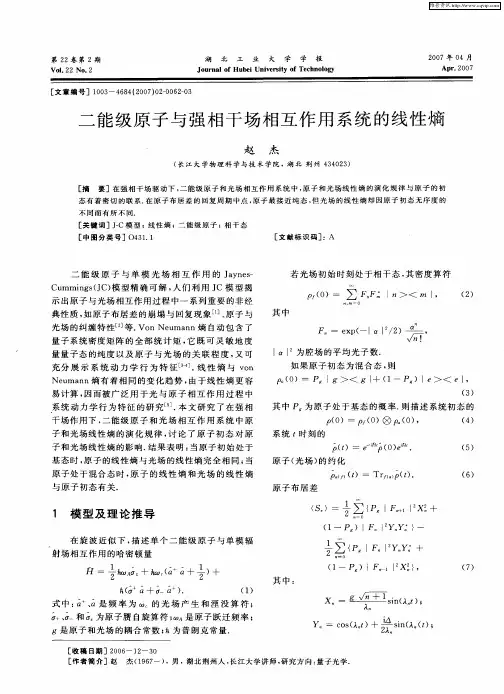
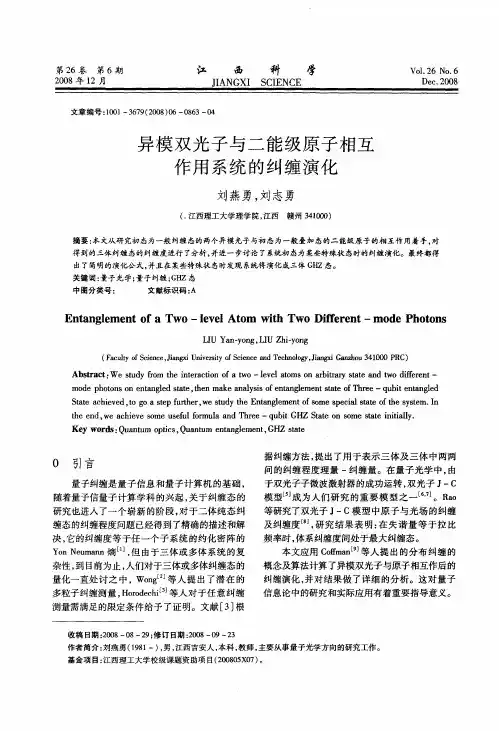
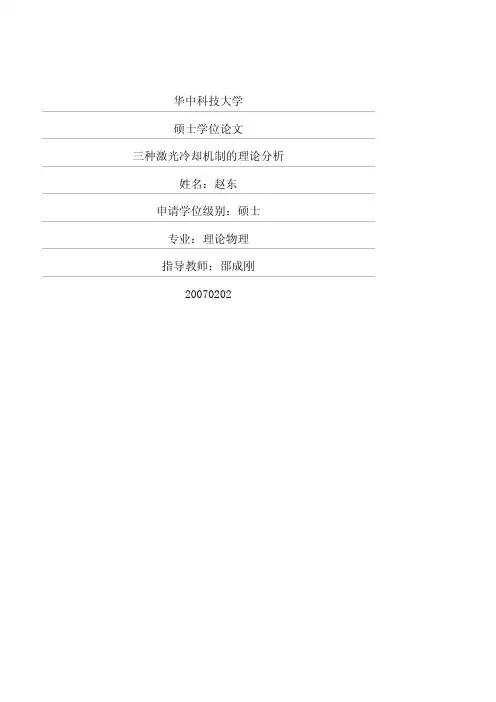
华中科技大学硕士学位论文三种激光冷却机制的理论分析姓名:***申请学位级别:硕士专业:理论物理指导教师:***20070202摘 要激光冷却广泛运用于科学技术中,比如波色-爱因斯坦凝聚的研究、广义相对论的验证、原子频标和原子干涉仪的研制等。
在光学粘胶中冷却原子,可达到多普勒冷却极限温度。
这时,再通过减弱激光强度和增大失谐量来继续冷却原子,能使其温度低于多普勒冷却极限。
要对原子进行深度冷却,即要突破反冲极限温度,可利用选择速度的方法,挑选出窄速度分布的原子。
虽然牺牲掉一部分原子,却得到单一速度的原子,故原子的温度就比较低。
本文主要讨论了三种冷却机制:多普勒冷却机制、亚多普勒冷却机制和亚反冲冷却机制。
多普勒冷却是基于光子的辐射压力来使原子减速;亚多普勒冷却是基于运动诱导造成的偏振梯度力使原子减速;亚反冲冷却是基于对原子的速度选择来获得单一速度分布原子,其可分为相干布陷冷却和拉曼激光冷却。
本文计算了速度选择的受激拉曼跃迁的三能级方程运动解析解。
得到了利用拉曼激光可以选择出特定速度分布的原子的结论。
首先利用半经典理论,作偶极近似,讨论了三能级原子系统和双光子的拉曼激光相互作用过程,在波函数中加入了速度参量,得到了三能级系统的演化方程。
然后,在弱场和大失谐条件下,把三能级方程退化为二能级方程。
最后用代换法把二能级方程化为常系数方程,得到了方程的解,理论结果和实验基本吻合。
本文还系统总结了一些其它文献中比较模糊的概念,比如相互作用哈氏量中磁场分量的忽略、激光选可见光、旋波近似等。
关键词:多普勒冷却,亚多普勒冷却,亚反冲冷却,相干布陷,拉曼激光,偏振梯度AbstractLaser cooling is widely applied in science and technique, such as Bose-Einstein condensation, verification for general relativity theory, atomic frequency scale and atomic interferometer etc. The temperature of atoms in the optical molasses could be cooled to the Doppler limit, and through weakening the laser intensity and increasing the detuning of the laser from the resonant frequency, the atoms could be further cooled below the Doppler limit. By velocity selection, one could get an atomic source with a narrow distribution in velocity and challenge the recoil limit temperature. Although some parts of the atoms are lost, the temperature of the remaining atoms, which have a uniform velocity, is quite low compared to the former.It discusses three mechanisms of laser cooling in this paper: the Doppler cooling mechanism, the Sub-Doppler cooling mechanism and the Sub-recoil cooling mechanism. The Doppler cooling which makes atoms slowdown is based on the radiation pressure of the laser; The Sub-Doppler cooling slows atoms down on the basis of polarization gradient forces caused by motive inductions; The Sub-recoil cooling including the coherent population trapping cooling and the Raman laser cooling, gets atoms with a slice velocity distribution depended on the velocity selection.It presents the analytical solutions of the three-level equations on the velocity-selective stimulated Raman transitions in this paper, and concludes the principle of selecting atoms with a uniform velocity out of an initial distribution. In the semi-classical theory and dipole approximation, we gets the evolution equations of the interaction of the three-level atoms with the two-photon Raman laser system, and the velocity parameter are also taken into account in the wave function. For weak lasers and large detunings, the three-level equations degenerate into two-level equations. Through transforming two-level equations into constant coefficient equations by substitution it gives the solutions of them. The theoretical analysis corresponds with the experimental results generally. It also generalizes a few concepts obscure in some papers systematically, such as ignoring the magnetic field component in theinteraction Hamiltonian, the choice of visible light for laser and rotating wave approximation etc.Key Words:Doppler Cooling, Sub-Doppler Cooling, Sub-Recoil Cooling,Coherent Population Trapping, Raman Laser, Polarization Gradient.独创性声明本人声明所呈交的学位论文是我个人在导师指导下进行的研究工作及取得的研究成果。
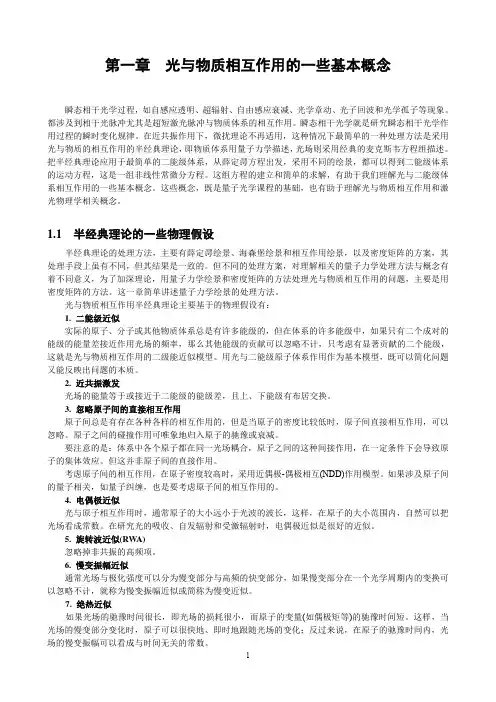
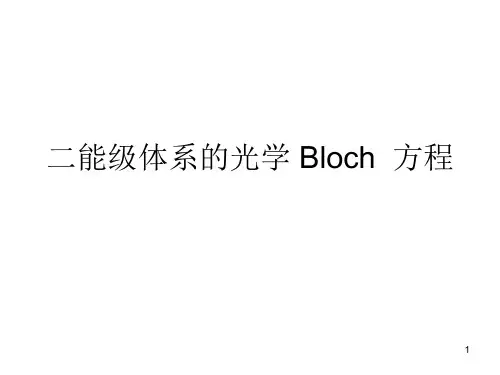
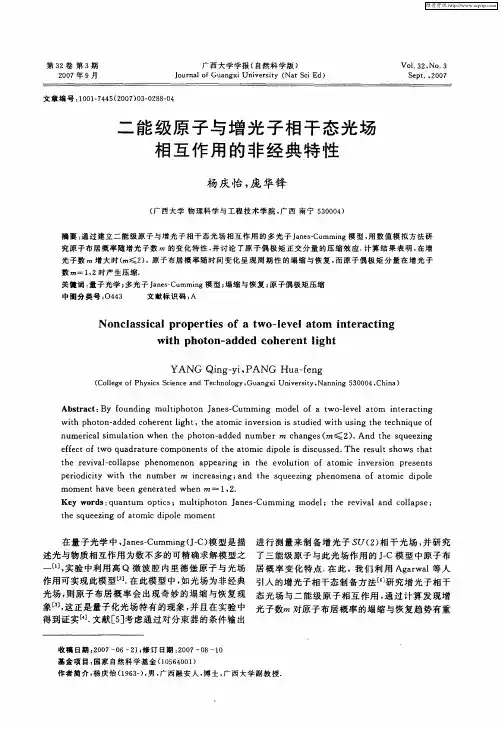
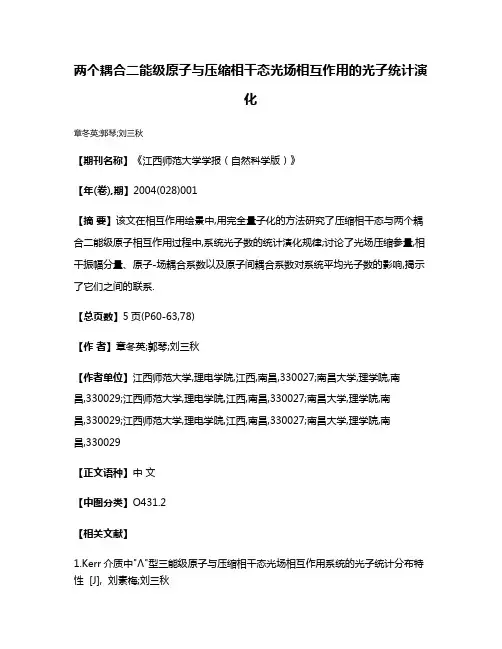
两个耦合二能级原子与压缩相干态光场相互作用的光子统计演
化
章冬英;郭琴;刘三秋
【期刊名称】《江西师范大学学报(自然科学版)》
【年(卷),期】2004(028)001
【摘要】该文在相互作用绘景中,用完全量子化的方法研究了压缩相干态与两个耦合二能级原子相互作用过程中,系统光子数的统计演化规律;讨论了光场压缩参量,相干振幅分量、原子-场耦合系数以及原子间耦合系数对系统平均光子数的影响,揭示了它们之间的联系.
【总页数】5页(P60-63,78)
【作者】章冬英;郭琴;刘三秋
【作者单位】江西师范大学,理电学院,江西,南昌,330027;南昌大学,理学院,南昌,330029;江西师范大学,理电学院,江西,南昌,330027;南昌大学,理学院,南
昌,330029;江西师范大学,理电学院,江西,南昌,330027;南昌大学,理学院,南
昌,330029
【正文语种】中文
【中图分类】O431.2
【相关文献】
1.Kerr介质中"Λ"型三能级原子与压缩相干态光场相互作用系统的光子统计分布特性 [J], 刘素梅;刘三秋
2.Kerr介质中耦合双原子与压缩相干态光场相互作用的光子统计演化 [J], 章冬英;刘三秋;郭琴
3.有效二能级原子与压缩相干态相互作用中光子数统计?… [J], 谢芳森;雷敏生
4.两个耦合二能级原子与压缩相干态光场相互作用系统中光场的相位特性 [J], 章冬英;刘三秋;陶向阳
5.相干态和压缩态光场与二能级原子相互作用的演化特性 [J], 吴朝新;顾樵;侯洵因版权原因,仅展示原文概要,查看原文内容请购买。
光子与原子相互作用的基本原理和现象解析光子与原子相互作用是量子力学中一个重要的研究领域,也是光谱学和量子计算等领域的基础。
本文将解析光子与原子相互作用的基本原理和现象,以帮助读者更好地理解这一领域。
光子是光的基本组成单位,它是量子力学中描述光波粒性的概念。
光子具有能量和动量,并遵循能量守恒和动量守恒的定律。
与光子相互作用的原子系统可以分为两个主要的情况:一是自由原子,二是束缚原子。
自由原子指的是原子处于无外界场的自由状态,束缚原子指的是原子受到某种外界场的束缚状态,比如原子在晶格中。
当光子与自由原子相互作用时,可以发生光电效应、康普顿散射和光背散射等现象。
其中最典型的是光电效应,即光子的能量高于一定能量阈值时,光子会被吸收,电子被激发并跃迁到连续能量态。
这种现象在实际应用中被广泛利用,例如用于光电转换装置。
康普顿散射是指当光子与自由电子碰撞时,光子的能量和动量会被散射,同时电子也发生散射。
光背散射是指当光子与自由原子或分子作用时,光子的能量和动量会被激发并发生散射。
对于束缚原子,光子与原子的相互作用可以导致原子的激发、退激发和光吸收等现象。
这种相互作用可以用来研究物质的结构和性质,例如原子光谱学中的拉曼光谱和拉曼散射等。
当光子与束缚原子相互作用时,光子的能量与原子的能级差相匹配时,光子会被吸收,从而激发原子跃迁到更高的能级。
当光子的能量与原子的能级差不匹配时,光子被散射,原子退激发到低能级。
另外,光子与原子相互作用还可以导致光的干涉、衍射和散射等现象。
光的干涉和衍射是光和原子之间相互作用的结果,通过它们可以研究光的波动性和原子的结构。
例如Young实验中的双缝干涉实验证明了光的波动性,而原子的Beugung 实验则证实了原子的波动性。
光的散射是指入射光在与原子碰撞后发生方向变化和能量损失的现象,其中最著名的是拉曼散射。
拉曼散射是指光子与原子或分子之间发生能量、动量和频率的交互转移,从而导致散射光的频移和强度变化。
光与二能级原子的相互作用二能级原子与光场的相互作用是最基本的模型,如图1为二能级原子与光场的相互作用。
图1二能级原子与光场的相互作用如图1所示,频率为v 的单模光场与二能级原子系统相互作用。
不考虑外界因素的影响,分析光场与原子相互作用。
其中,m 表示激发态,n 表示基态,原子在上下能态之间作简谐振荡,其中拉比频率为Ω,原子跃迁频率为ω,探测光的失谐量为v -=∆ω,激发态到基态的自发辐射衰减率为Γ,相干衰减率为()2/n m γγγ+=,二能级的电偶极矩矩阵元为n r m e mn =℘。
该系统的总哈密顿量由自由哈密顿0H 和光与原子相互作用的哈密顿1H 。
系统的总哈密顿量为10H H H +=。
nn m m H n m ωω +=0(3.1.2)m n e n m e H ivt ivt *122Ω-Ω-=- (3.1.3)根据考虑耗散作用的密度矩阵方程:[]{}ρρρ,21,Γ--=H i ()()∑∑Γ-Γ---=k kj kj kj ik k kj kj kj ik ij H H i ρρρρρ21 (3.1.4)利用可以得到:()()mm nn ivt mn mn mn nm ivt mn ivt nn nn mn ivt nm ivt mm mm e i i e i e i e i e i ρρργωρρρρρρρρρ-Ω++=Ω-Ω+Γ=Ω-Ω+Γ-=---22222**1 (3.1.5)做慢变振幅近似有:ivt mnmn e -=ρρ~,mm mm ρρ~=,nn nn ρρ~=()()mm nn mn mn nm mn nn nn mn nm mm mm i i i i i i ρρργρρρρρρρρρ~~2~~~2~2~~~2~2~~**1-Ω+-∆=Ω-Ω+Γ=Ω-Ω+Γ-= (3.1.6)由系统封闭条件:1~~=+nnmm ρρ令方程左边倒数部分为零,求解可得:()()()()()()[]222222222222222/2/~/2/~/2/~∆+Ω+Γ∆-ΓΩ=∆+Ω+Γ∆+Ω+Γ=∆+Ω+Γ∆+Ω=γγγργγγγργγγγρi i mn nn mm (3.1.7)由极化强度关系:[]..~..210c c e c c e E P ivt mn nm ivt +℘=+=--ρχε(3.1.8)Ω℘=''+'= 02~2ερχχχmnmn N i (3.1.9)由此得到探测光极化率的实部χ'和虚部χ'',它们分别表示色散和吸收()()()()mm nn mn mm nn mn N N ρργεγχρργεχ~~~~22022202-∆+℘=''-∆+∆℘=' (3.1.10)其中,令0~,1~==mm nn ρρ,原子数密度为N ,真空介电常数为0ε,绘制出探测光的吸收和色散随其失谐量变化的曲线,如图2所示。
光子与原子相互作用的基本原理光子是光的基本单位,是一种电磁波粒子。
而原子是物质的基本单位,包含了质子、中子和电子等粒子。
光子与原子之间的相互作用是光学和量子力学的基础,对于理解光的传播和物质的性质具有重要意义。
本文将从光子的产生、传播以及与原子的相互作用等方面,探讨光子与原子相互作用的基本原理。
一、光子的产生与传播光子的产生源于原子的能级跃迁。
当原子处于高能级时,电子可以吸收能量而跃迁到更高的能级,此时原子吸收了光子。
而当原子处于激发态时,电子可以从高能级跃迁到低能级,释放出能量,此时原子发射了光子。
这种能级跃迁过程是光子产生的基本机制。
光子的传播遵循电磁波的性质。
光的传播是通过电磁场的变化而实现的,电磁场的变化导致电场和磁场的相互作用,从而形成电磁波。
光子作为电磁波的载体,具有波粒二象性,既可以看作是电磁波的一部分,也可以看作是能量量子的载体。
光子在真空中传播的速度是光速,这是由于光子没有质量,所以能以最大速度传播。
二、光子与原子的相互作用光子与原子的相互作用是光学和量子力学的基础。
在光学中,光子与原子的相互作用可以解释光的吸收、散射和透射等现象。
在量子力学中,光子与原子的相互作用可以解释原子的激发和退激发过程,以及光的干涉和衍射等现象。
光子与原子之间的相互作用可以通过电磁场的相互作用来描述。
当光子与原子相互作用时,光子的电场和原子的电荷分布发生相互作用,从而引起原子的激发或退激发。
这种相互作用可以通过电偶极子的概念来描述,即光子的电场与原子的电偶极矩之间的相互作用。
除了电偶极子相互作用外,光子与原子之间还存在其他形式的相互作用。
例如,当光子的频率与原子的共振频率相匹配时,会出现共振吸收现象。
此外,光子还可以使原子的电子发生跃迁,从而改变原子的能级结构。
这些相互作用过程在光学和量子力学中都有广泛的应用。
三、光子与原子相互作用的应用光子与原子相互作用的基本原理在许多领域都有重要应用。
在光学中,光子与原子的相互作用可以用于光谱分析、激光技术和光通信等方面。
光与二能级原子的相互作用
二能级原子与光场的相互作用是最基本的模型,如图1为二能级原子与光场的相互作用。
图1 二能级原子与光场的相互作用
如图1所示,频率为v 的单模光场与二能级原子系统相互作用。
不考虑外界因素的影响,分析光场与原子相互作用。
其中,m 表示激发态,n 表示基态,原子在上下能态之间作简谐振荡,其中拉比频率为Ω,原子跃迁频率为ω,探测光的失谐量为v -=∆ω,激发态到基态的自发辐射衰减率为Γ,相干衰减率为
()2/n m γγγ+=,二能级的电偶极矩矩阵元为n r m e mn
=℘。
该系统的总哈密顿量由自由哈密顿0H 和光与原子相互作用的哈密顿1H 。
系统的总哈密顿量为10H H H +=。
n n m m H n m ωω +=0
(3.1.2) m n e n m e H ivt ivt *12
2Ω-Ω-=-
(3.1.3)
根据考虑耗散作用的密度矩阵方程:[]{}ρρρ
,2
1
,Γ--=H i ()()∑∑Γ-Γ---=k
kj kj kj ik k kj kj kj ik ij H H i ρρρρρ
21
(3.1.4)
利用可以得到:
()()mm nn ivt mn mn mn nm ivt mn ivt nn nn mn
ivt
nm ivt mm mm e i i e i e i
e i e i
ρρργωρ
ρρρρ
ρρρρ-Ω++=Ω-Ω+Γ=Ω-Ω+Γ-=---2
2
22
2**1 (3.1.5)
做慢变振幅近似有:ivt mn mn e -=ρρ~,mm mm ρρ~=,nn
nn ρρ~= ()()mm
nn mn mn
nm mn nn nn mn nm mm mm i i i
i i i ρρργρρρρρρρρρ~~2~~~2~2~~~2
~2~~**1-Ω+-∆=Ω-Ω+Γ=Ω-Ω+Γ-=
(3.1.6)
由系统封闭条件:1~~=+nn
mm ρρ 令方程左边倒数部分为零,求解可得:
(
)
(
)
()()
()()[]
2222222222
22222/2/~/2/~/2/~∆+Ω+Γ∆-ΓΩ=∆+Ω+Γ∆+Ω+Γ=
∆+Ω+Γ∆+Ω=
γγγργγγγργγγγρi i mn
nn mm
(3.1.7)
由极化强度关系:
[]
..~..210c c e c c e E P ivt mn nm ivt +℘=+=--ρχε
(3.1.8)
Ω
℘=
''+'= 02~
2ερχχχmn
mn N i
(3.1.9)
由此得到探测光极化率的实部χ'和虚部χ'',它们分别表示色散和吸收
()
()()
()mm
nn mn mm
nn mn N N ρργεγ
χρργεχ~~~~2202
2
2
02
-∆+℘=
''-∆
+∆
℘=' (3.1.10)
其中,令0~,1~==mm nn ρρ,原子数密度为N ,真空介电常数为0
ε,绘制出探
测光的吸收和色散随其失谐量变化的曲线,如图2所示。
图2 探测光的吸收和色散随其失谐量变化,红色虚线表示色散,蓝色实线表示吸收。
如图2所示,可见在光与二能级原子处在共振状态时,虽然有强烈的色散,但同时也很大的吸收。
在远离共振处时,吸收和色散都很小。
在低损耗条件下,实现近共振处的线性以及非线性光学效应都是十分不利的。
而EIT 效应却可以有效地降低介质对光的吸收,同时增强色散,并应用于调控光的群速度、增强非线性效应、无粒子数反转放大激光、实现关联光子态存储以及实现单光子的制备和存储等多个方面错误!未找到引用源。
A b s o r p t i o n a n d D i s p e r s i o n
The probe detuning(∆/γ)。